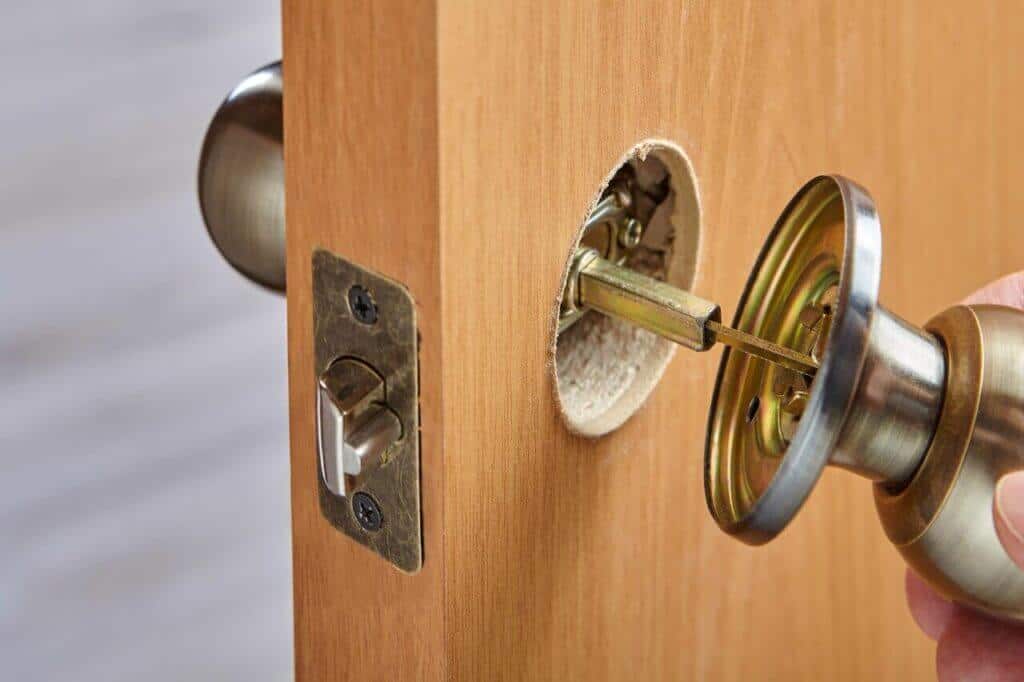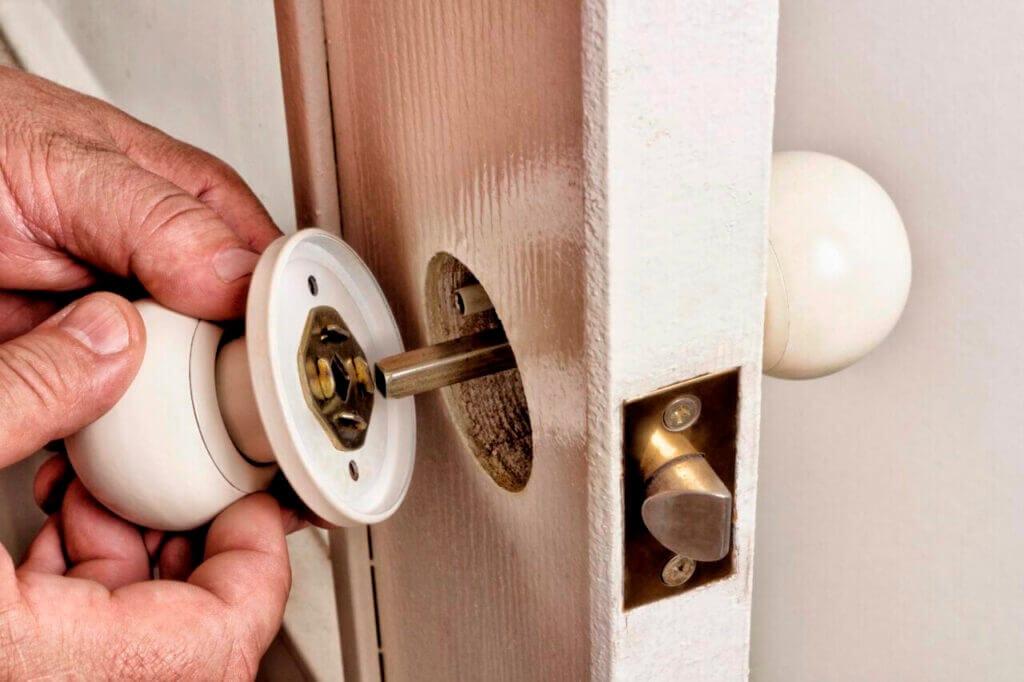One of the biggest woes your door and lock can give you has to be a stuck door latch. If your door is unable to retract or extend the latch, then your door would pose a sighing inconvenience at best and a direly serious security concern at worst. This is because it would lead to impeding the door from opening or closing, as well as locking and unlocking.
The worst offender is undoubtedly when your front door won’t latch, which results your front door not locking and leaves your door vulnerable to break—ins. Or it may not lock properly, which is still a big compromise that can allow someone to use a moderate amount of force to find their way into your house. Especially with a spike in property crime rate in Oakville, you should make sure to have top—notch and robust security for your house to keep yourself and your loved ones safe.
Even if the door latch stuck open is affecting your interior door, it is not quite an ideal situation. While it is not a security concern, it can pose a privacy concern. Nobody wants to stumble into the embarrassing situation of accidentally walking into an improperly closed door of an occupied bathroom!
If your door latch won’t retract, that would certainly do you no favors either. A door latch stuck closed can lock you out of your home. Scratching your head in front of your stubbornly shut door after a long day at work has to be especially unpleasant. Additionally, a door that would not open can not just be highly inconvenient when you want to exit your house, but also even dangerous in the case of an emergency.
With that in mind, you should seek solutions promptly as soon as you notice your latch is sticking, as it is among the most lock security concerns that should never be neglected. While some DIY methods may be easy to implement to get it resolved, you should seek a reliable locksmith’s lock repair services for the more complicated procedures.
Lubricate the Door Latch
Lubrication is a ‘magic’ solution for a variety of door and lock problems, and it might be just the perfect way to get your door latch unstuck. Due to the excessive lack of lubrication, the latch may face friction when moving about. This can cause it to be unable to retract or extend properly or entirely, resulting a stuck door latch. Lubricating the latch can get rid of that annoying friction and get the latch back to moving properly.
You may be tempted to turn to your handy WD—40 for it, but while it can do the work, it may be better to turn to other better—suited alternatives. Petroleum—based lubricants like WD—40 can attract accumulation of grime, and hence it is not deemed the best course of action for latches. Your better alternative would be a graphite, Teflon or dry lubricant. You may especially benefit from a lubricant that provides a flexible straw, so that the lubrication is allowed to be thoroughly applied to the latch.
Put a moderate amount of lubricant into the latch and then wait for a few minutes for it to spread. Once a few minutes have passed, open and close the door to operate the latch so that the lubricant reaches more parts and implements its effect optimally. This procedure may require you to repeat it a few times to show its effects.
Another plus side of lubricating the latch is it cleaning up the latch and protecting it from moisture damage. Hence, lubrication for your latch is very beneficial overall, and you should lubricate it now and then.
Clean Rust from the Door Latch
High humidity in the air can easily make you a bit miserable, and unfortunately your latch and lock are no exceptions to this. Especially during a weather heavy with moisture in the air, the latch can be vulnerable to rust accumulation. Besides rust, the latch and lock components accumulate various other elements like debris, dust and grime. An excessive build—up of these elements in these components can restrict the movement of latch due to friction, causing troubles in door latching or unlatching.
Vinegar can be a very effective method for rust removal in this case. You will have to take the latch and/or whole lock out of the door. Then submerge the components into a solution of vinegar and water. Allow them to soak for up to a day so that the rust is effectively dissolved from the parts. Once about a day has passed, take them out of the solution and wipe them thoroughly. Make sure to dry them off completely before installing them back.
Alternatively, you can coat a cotton swab with vinegar and apply it to the latch and/or other lock components. Just like the aforementioned method, you should let the components sit with vinegar on them for some minutes for the vinegar to do its work. Then you can use an unused toothbrush to scrub off the rust that should now be easily removable.
In some cases, the rust may be too persistent if too much of it has built up robustly. In this case, it may be best to disassemble the lock to clean with more through means. A professional locksmith’s intervention may be better in this case, as such procedure is likely to be too complicated for a layperson.
Align Strike Plate
A strike plate is the metal plate located on the door frame that the latch bolt extends into. The misalignment between latch and the strike plate on the door is an extremely common issue among the reasons for a stuck door latch. This issue is strongly indicated if the door latch won’t retract when you try to open a closed door, but it would operate fine without getting stuck when you close the door—however, this is not necessarily the case, of course.
When the alignment is out of order, the latch is impeded from extending into the strike plate hole properly. It has to exert force to move about. Of course, it is also possible that a door won’t latch due to such misalignment.
One way to resolve this is to alter the alignment strike plate so that it can align with the latch again. In order to begin with implementing this solution, the exact location of misalignment needs to be figured out. In order to do that, a marking material like lipstick can be spread on the latch. Once you shut the door and then reopen it, you’d find the spot where the latch scrapped on the strike plate thanks to the marking material.
From there on, the strike plate would have to be unscrewed to be taken off the door frame. Then you can drill new screw holes for the strike plate to be fit into in order to be realigned with the latch. The old screw holes can be filled with a wood dowel. Once the screw holes are sorted out, the strike plate can be fixed into them and your latch should be realigned with the latch if the procedure was properly done.
As you can tell, this is a procedure that requires proper expertise. If you lack the skills for it, then it is easy for the DIY repair to go awry and worsen your problem. When in doubt, leave the work to a locksmith who is adept at fixing such issues without posing further problems!
Replace the Damaged Door Knob Spindle
A spindle is a metallic rod that serves as a connection between the two door handles at each side of the door. When a door knob is turned, it rotates which puts the latch into work, allowing to open or close the door. Hence, if this essential component has been damaged in some way, then the connection to the latch would be affected. This would cause the latch to not be operate from either knob or both knobs, and hence cause it to be stuck even if you turn the knob.
In order to fix this issue, you would likely have to replace the spindle. However, the procedure of securing the right spindle, removing the old spindle, and then installing the spindle can be complicated if you do lack the proper expertise about it. As such, it may be best left to a locksmith.

Tighten the Door Hinge Screws
Alternatively, the misalignment between the latch and strike plate may not be an issue coming from the strike plate itself. Over time and usage, the door hinge screws can get loose. This would impede support of the door and cause it to sag. When this happens, the latch would get out of alignment with the strike plate. This would likely cause a rubbing door as well.
If you notice the location where the door rubs, you can locate the loose screws. Then you can just tighten them with a screwdriver. Be careful not to over—tighten them. Any stripped screws should be replaced with new ones.
Use a Hammer to Loosen a Door Latch That Won’t Retract
If your door latch won’t retract, then a few light bumps at the latch with a hammer can help. However, you should take a lot of caution with this method. You certainly do not want to end up damaging your latch mechanism, other lock components or the door during the process. However, if there is an underlying issue within the components, then this would not serve as a reliable long—term solution. Although, it can help you with locking your door and keeping it secure until the issue is completely fixed.
Slide a Credit Card to Open a Door Latch Stuck Closed
You might be able to use a credit card or another similar plastic material to open a stuck latch. Slide it through the gap between the door and latch location. Then attempt to push down the latch with it, while trying to open the door. If it manages to work, then similar to aforementioned method, this may also better serve as a temporary solution to get your door opened to let you in or out. That is because there may be a deeper issue underlying which caused the latch to be stuck in the first place.
Replace the Door Latch or Door Lock
The door latch or whole lock mechanism may have worn down to the point of requiring a replacement. Alternatively, there may be specific components requiring replacement or repair. In either case, as these mechanisms have intricate interior structure, it is best to leave the diagnosis and proper course of action to a locksmith who has the proper expertise to deal with it.

Call an Expert Locksmith to Fix the Jammed Door Lock Latch
There can be a myriad of reasons that cause a stuck door latch, whether it is lack of lubrication, build—up in latch mechanism, or a misalignment relating to the door. Either way, diagnosing the issue can be time—consuming for a layperson. Even with that out of the way, implementing the right way to fix a door latch sticking issue can be complicated. You can risk damaging the latch, lock or the door throughout the process, adding up to your problem.
An expert locksmith can help resolve the issue promptly without posing the risk of damage. If you are looking for a Iocksmith in Oakville to get the door latch issue resolved, then you can put your trust in Faster Locksmiths. Our expert locksmiths are adept at fixing door latch and any other lock issues, as well as problems relating to door alignment and strike plates. We can get your door latch back to securing your house reliably in no time!